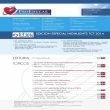This study included 358 patients considered inoperable, randomized to TAVR with expandable balloon valve versus conservative treatment. The 5-year end points included all-cause mortality, cardiac mortality, re-hospitalization, and stroke. At 5 years, mortality from all causes was lower in TAVR group versus conservative treatment group (71.8% versus 93.6%, P <0.0001). By dividing patients by STS<a href="https://solaci.org/en/2015/06/24/congress-item-8246/" title="Read more" >...</a>
CLEAN-TAVI: transcatheter aortic valve replacement with cerebral protection
The stroke is a leading complication of post transcatheter aortic valve implantation increasing up to 3 times the mortality of these patients. In the works performed neuroimaging new post, TAVR defects were observed in two-thirds of patients and this increases the risk of post clinical stroke. There is a missing data in the literature of<a href="https://solaci.org/en/2015/06/24/congress-item-8253/" title="Read more" >...</a>
American Registry for percutaneous aortic valve replacement,one-year evolution of nearly 6000 patients
TVT STS / ACC registrywas developed to obtain data from all patients undergoing percutaneous aortic valve replacement (TAVR) in the United States. The clinical outcome at 30 days was recently published (Macket al, JAMA 2013) but there are few data on the longer-term treatment that is already incorporated in clinical practice in the United States.The<a href="https://solaci.org/en/2015/06/24/congress-item-7707/" title="Read more" >...</a>
CoreValve superior to surgical aortic valve replacement in high-risk patients
The aim of this study was to compare percutaneous aortic valve replacement (TAVR) with the self-expanding Valve Core with conventional surgery in patients at high surgical risk. Patients with a valve area < 0.8 cm2 , valvular index ≤ 0.5 cm2 , a mean gradient of > 40 mmHg or peak speeds above 4m /s<a href="https://solaci.org/en/2015/06/24/congress-item-7616/" title="Read more" >...</a>
PARTNER cohort B: Clinical events at 3 years follow-up in patients with
Background: Percutaneous aortic valve implantation (TAVI) is the treatment of choice for patients with severe aortic stenosis considered inoperable according to clinical outcomes at 12 months as reported in the PARTNER study, which demonstrated a reduction in mortality and an improvement in the quality of life for patients. However, the long term benefit of this<a href="https://solaci.org/en/2015/06/24/congress-item-7035/" title="Read more" >...</a>
Educational Journal N° 98
1. ESTUDIOS DE TECNOLOGIAS EN INTERVENCIONES CORONARIAS • RIBS IV – Presentador: Fernando Alfonso • ABSORB II – Presentador: Patrick Serruys 2. ESTUDIOS DE FARMACOLOGIA EN INTERVENCIONES CORONARIAS • ISAR-TRIPLE – Presentador: Nikolaus Sarafoff • SECURITY – Presentador: Antonio Colombo • BRIGHT – Presentador: Yalin Hang 3. ESTUDIOS EN IMÁGENES CORONARIAS • IVUS-CTO – Presentador:<a href="https://solaci.org/en/2015/05/19/educational-journal-n-98/" title="Read more" >...</a>
Results of the new repositionable and retrievable percutaneous valve system
Original title: Transcatheter Aortic Valve Replacement for Severe Symptomatic Aortic Stenosis Using a Repositionable Valve System. 30-Day Primary Endpoint Results From the REPRISE II Study. Reference: Ian T. Meredith AM et al. J Am Coll Cardiol 2014;64:1339–48. Transcatheter aortic valve replacement (TAVR) showed results comparable to those of surgery in patients at high surgical risk, but complications can<a href="https://solaci.org/en/2015/01/29/n-4943/" title="Read more" >...</a>
Stress echocardiography in low flow, low gradient aortic stenosis with deteriorated systolic function
Echocardiography Favaloro Foundation. Buenos Aires, Argentina. JACC Cardiovascular Imaging has recently published a retrospective analysis including severe aortic stenosis patients (< 1 cm²), with low gradient (mean aortic gradient Patients that had undergone dobutamine stress echocardiography (DSE) to distinguish pseudo aortic stenosis (n=49) were selected. These results were used to determine flow reserve (FR). The<a href="https://solaci.org/en/2014/12/18/n-4866/" title="Read more" >...</a>
The delay between the indication and the embodiment of the procedure decrease the effectiveness of percutaneous aortic valve replacement
Original title: Impact of wait times on the effectiveness of transcatheter aortic-valve replacement (TAVR) in severe aortic valve disease: a discrete event simulation model. Reference: Wijeysundera HC et al. Can J Cardiol. 2014; Epub ahead of print. Once patients are accepted for percutaneous aortic valve replacement (TAVR), the higher the expected for the valve, the greater the risk<a href="https://solaci.org/en/2014/06/17/n-4530/" title="Read more" >...</a>
Core Valve in high-risk patients, superior to surgical replacement at one year
Original title: Transcatheter Aortic-Valve Replacement with a Self-Expanding Prosthesis. Reference: David H. Adams et al. N Engl J Med. 2014 Mar 29. [Epub ahead of print]. Transcatheter Aortic valve replacement (TAVR) with balloon expandable valve showed survival improvement in inoperable patients and was similar to surgery inoperable high-risk patients. An alternative to the above device is the self-expandable<a href="https://solaci.org/en/2014/04/09/n-4390/" title="Read more" >...</a>









